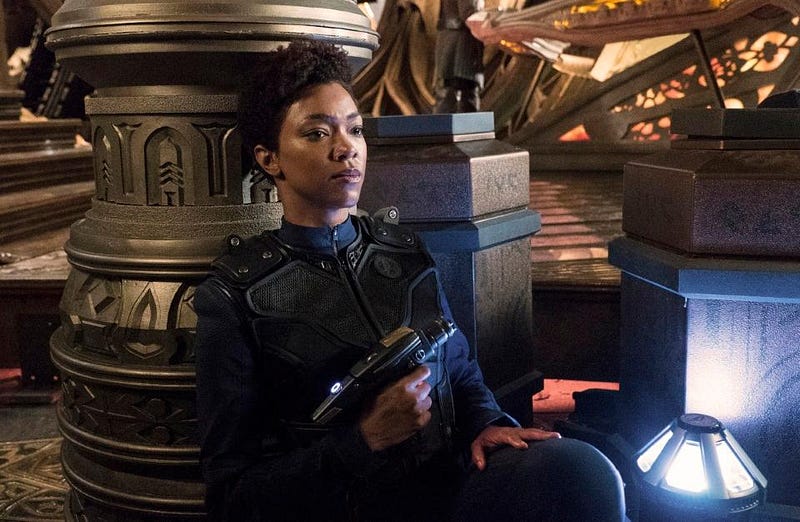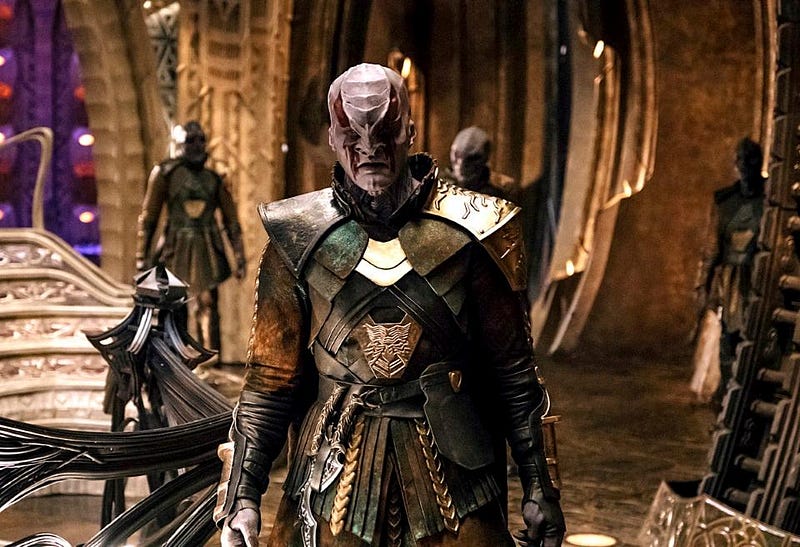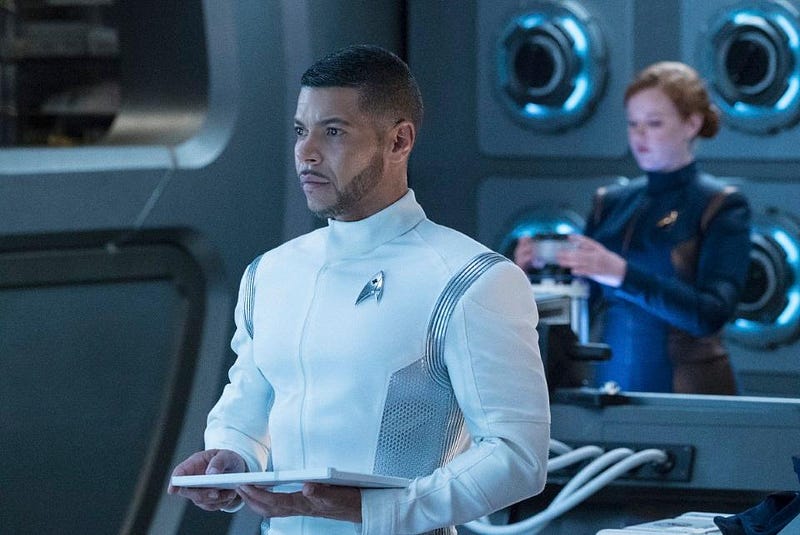Star Trek: Discovery’s Unanswered Scientific Questions After Season 1, Episode 9

It’s more than the Spore Drive, it’s about the heart of science fiction.
If you’ve been following Star Trek: Discovery, you knew what we were headed for going into the mid-season finale episode: Into the Forest I Go. There’s a war happening between the Federation and the Klingons, precipitated by T’Kuvma on the Klingon side and the Captain and the mutinous, impulsive first officer of the USS Shenzou. T’Kuvma is dead; Captain Georgiou is dead; first officer Burnham is court martialed and then reassigned to the USS Discovery, which is the Federation’s greatest weapon and warship. Discovery’s secret weapon is the mycelium spore drive, which leverages a magic space network of fungi to instantly “jump” anywhere in the known Universe, and (potentially) even into parallel Universes.
As the war continues, a power-hungry Klingon named Kol rises to fill the power vacuum left by T’Kuvma’s death, while Voq (his protege) disappears and L’Rell, after months as a torture specialist, develops Federation sympathies and has a mysterious connection to her former prisoner, Lieutenant Ash Tyler. Tyler and Burnham join spore-drive inventor Paul Stamets, bumbling Cadet Sylvia Tilley, First Officer Saru, and Captain Gabriel Lorca aboard Discovery, as they try and out-fight the Klingons. However, the cloaking technology is too much to overcome, and the Federation is losing. After making contact with the peaceful Pahvans, who begin broadcasting to both the Federation and the Klingons, a showdown is coming between the Klingon flagship and Discovery. That’s where the episode begins.

Recap: The USS Discovery is ordered back to a starbase, leaving the Pahvo defenseless. Lorca, however, goes only at Warp 5, so that they can look like they’re obeying orders while ready to jump back at a moment’s notice. The Federation has been unable to crack the cloaking code, so of course Discovery comes up with a method to do it in under 2 hours. The key? Install two beacons aboard the Klingon ship, then jump 133 times around it, and then they’ll be able to know exactly where it is. No problem, right? Except:
- the beacons must be installed aboard the Klingon ship by hand, apparently,
- the beacons light up and talk when they’re activated,
- and the 133 jumps must be done by Stamets, whose mind and health are degenerating from using himself to power the spore drive.
So Lorca decides to send Tyler, the son-he-never-had, and inexplicably lets Burnham talk him into allowing her to go, even though literally anyone else would be more prone to actually following orders to carry out the mission.

The rationale they give for this mission is that they can’t detect the cloaked Klingon ship, and that the Klingon ship can’t attack while cloaked. This is super bizarre, because “long-range scanners detect a cloaked Klingon vessel coming out of warp” is literally what they say on the show, and the first Federation Admiral we met, Brett Anderson, has his flagship destroyed after being rammed by the cloaked Klingon ship-of-the-dead, which is literally the ship they’re fighting here. Never mind that; they beam aboard and install the first beacon, then they detect a human lifesign. Does Burnham ignore the red herring and complete the mission? Of course not; she feels compelled to bring everyone home, which in this case turns out to be the injured (and possibly legless) Admiral Cornwell, captured a few episodes earlier.

Also in there is L’Rell, triggering Tyler’s PTSD; Burnham must complete the mission herself, which leads to a one-on-one battle with Kol. She stays alive long enough to buy Discovery enough time to figure it all out. Stamets nearly dies, but makes all 133 jumps. The beacons work, and they gather the needed data. Saru’s algorithm pieces the whole thing together in five minutes. And then Discovery fires three photon torpedoes at the cloaked ship-of-the-dead, which (surprise, surprise) is exactly where it was before it cloaked. Tyler, Cornwell, L’Rell, and Burnham are all beamed out, and the Klingon ship explodes. Despite a slew of questionable decision-making, it all works out.
Lorca is offered accolades, Stamets is exhausted and has had an epiphany after seeing so much of the Universe through the mycelium’s metaphorical eyes, Burnham has some redemption going, and everyone lives this time. So for some inexplicable reason, with the danger behind them, Stamets offers to jump one last and final time, before retiring to share his knowledge of the Universe. (Why not warp? The difference is literally only hours.) Well, he takes a jump, and everything goes wrong, and no one knows where Discovery is. (Probably in a parallel Universe.) And that’s the end of the mid-season finale.

The Science: There is some interesting science in this, but not all of it is good. The cloaking device is interesting; it works differently than modern-day invisibility materials. While these metamaterials bend electromagnetic radiation around an object, making them effectively invisible across a variety of wavelengths, this cloaking device alters the gravitational field around a ship. The odd thing is, it would have to have a negativegravitational effect on one side, to push light away from it, and then a series of positive and negative effects to bring it back and focus it onto the original direction. But this should protect you from things like photon torpedoes as well; you should be not only cloaked but shielded if this were the effect. It’s interesting, but I’m not sure the science adds up in this fiction.
The Universal Translator is awesome, and works almost exactly like modern-day translation software works. It’s almost a perfect advertisement for the Google Pixel 2, and works nearly the same way. Even the Klingons marvel at it.

Tyler is absolutely a PTSD victim, and the depiction of how one’s mind works when PTSD is triggered is scarily accurate for many. This is a well-done scene that should hopefully help normalize a real injury that’s all-too-often ignored because it’s not a visible injury. We’ve never seen any evidence of Tyler’s PTSD before, and this is normal; it’s often invisible to the outside world, until it isn’t anymore.

The spore drive is problematic for a large number of reasons, including:
- It claims to work on the principle of quantum entanglement, but quantum entanglement does not allow for the instantaneous transfer of information from one place to another.
- Even if it did, there’s no way to instantaneously transfer matter from one place to another, not without curving spacetime enough to connect two causally disconnected events in spacetime.
- Fungi are highly evolved, and didn’t come to be on Earth until Earth had been around for billions of years. The idea that there would be a pan-galactic network of fungi throughout space doesn’t jibe with what we know about evolutionary biology.
For the purposes of this episode, this is one of those “suspension of disbelief” fantasy moments where we simply have to accept that this inexplicable technology must be real for the plot to work.

But the parallel Universes part is the hardest part for me to swallow. Newly introduced in this episode, Lorca shows Stamets how all the data gathered from the spore drive shows not only the mycelium network, but doorways to parallel Universes. They build off the many-world interpretation of quantum mechanics to indicate that Universes where anything and everything that can happen does, only in some other parallel Universe. The problem is, these branches occur at an “event” in spacetime, which means they occur at a specific location in space at a specific time; you can’t simply have a “map” of a place where you can access a parallel Universe. Yet that’s how Star Trek: Discovery chooses to portray the science, and it appears that’s where they wind up at the end: in a parallel Universe that’s nowhere known.

Right and Wrong: Of all the incarnations of Star Trek, perhaps Discovery’s greatest weakness is its inability to confront the audience with ethical dilemmas that have a resolution that gets discussed. There are no moral lessons associated with the show, nor is there one with this episode or the first season’s story arc. Burnham doesn’t learn to trust her superiors; she also doesn’t make better decisions. She just gets away with this particular set of actions not having the same bad consequences that similar actions previously had. Lorca continues to be opportunistic and manipulative, showing compassion and playing to people’s interests and ideals, but only to serve his own needs. The inconsistent personality of Stamets is troubling, and touches on the idea of whether eugenics and self-experimentation is ethical, and allows us to see how it impacts his primary interpersonal relationship with Culber.

But “right and wrong” aren’t at the center of Star Trek: Discovery. Figuring out what the right thing to do is doesn’t seem important to this series; getting the desired outcome is. Cornwell treats Tyler like a soldier because she needs a soldier; Burnham saves Cornwell because her prior failures haunt her; Tilly confronts Stamets and Culber with their lies-of-omission because she’s a careless, blundering, well-meaning fool when it comes to interpersonal relationships. But at no point do they explore or recap these ethical problems, or talk about the dilemmas they faced and why they made the choices they did.
Most disappointingly: the war. The Klingons really are, nine episodes in, just one-dimensional villains. The Federation very clearly have no interest in “assimilating” or erasing Klingon culture; they simply want a cease-fire. One murderous, warlord-like Klingon is replaced with another, as they all die senselessly in battle, accomplishing nothing. Of course, when you’re attacked, you must defend yourself, but the Klingons have no motivation to continue this war. Yet as the episode nears its end, the war continues all the same. Perhaps it’s a practical consideration; when you’re winning, it’s easy to keep going. Perhaps with the cloak-detection technology, peace will appear on the horizon?

Conclusion: A lot of people are going to get worked-up about a lot of things: the Burnham/Tyler romance, the Culber/Stamets kiss, the L’Rell/Tyler history, and whether Tyler is a genetically-altered Voq or not. The action sequences and the battle scenes are impressive, as is the fight choreography, the visuals and sets, and finally introducing the Universal Translator so that we don’t have to listen to tons of the slow, plodding Klingon language were all extremely well-executed. The characters have the potential to develop further in very interesting ways. Unlike other incarnations of Star Trek, there is tremendous room for character growth, as everyone is flawed but has redeeming qualities, or so it appears. It did take multiple seasons for shows like The Next Generation, Voyager, and Enterprise to start consistently cranking out compelling stories with heart. Maybe Discovery will follow that same pattern.

But at this point, it needs to grow. All that’s happened so far seems like a setup for a real, continuing adventure that we have yet to begin. Perhaps the parallel Universe idea, first brought to the small screen by The Next Generation where the fabric between differing realities broke down, will enable the USS Discovery to explore strange, new worlds where history has broken down differently. Where the Shenzou gave a “Vulcan hello” and war was averted; where Georgiou won her hand-to-hand combat with T’Kuvma; where Landry doesn’t commit suicide-by-tardigrade; where Mudd gives the spore drive to the Klingons; where Kol destroys both the USS Discovery and Pahvo. Star Trek: Discovery still needs to find its heart, but perhaps by going where no one has gone before, it will become the series it was always meant to be. Come back in January, and we all just might find out!
Ethan Siegel is the author of Beyond the Galaxy and Treknology. You can pre-order his third book, currently in development: the Encyclopaedia Cosmologica.





